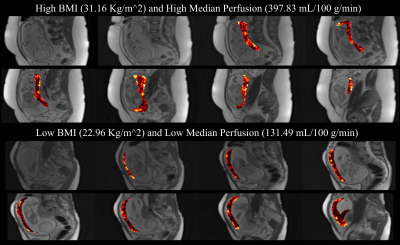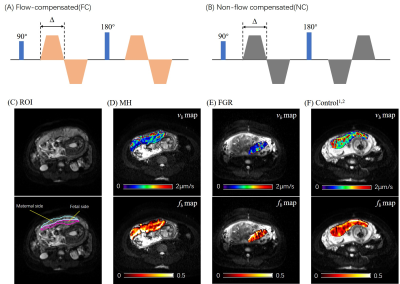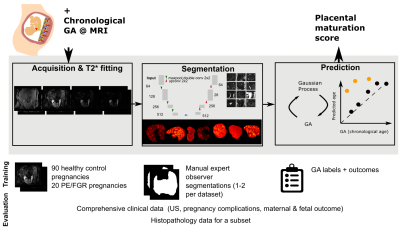Oral
Maternal-Fetal Imaging
ISMRM & SMRT Annual Meeting • 15-20 May 2021

| Concurrent 5 | 12:00 - 14:00 | Moderators: Charles McKenzie & Daniela Prayert |
0705. |
Characterization of placental contractions in healthy pregnancies
Neele S Dellschaft1, Rachel Allcock1, Jana Hutter2, Lopa Leach3, Nia Jones4, and Penny Gowland1
1Sir Peter Mansfield Imaging Centre, University of Nottingham, Nottingham, United Kingdom, 2Department of Perinatal Imaging and Health, King's College London, London, United Kingdom, 3Life Sciences, University of Nottingham, Nottingham, United Kingdom, 4Division of Child Health, Obstetrics and Gynaecology, University of Nottingham, Nottingham, United Kingdom
Subclinical uterine contractions in the third trimester have been detected with MRI in recent years and we regularly observe these contractions in 10 minute longitudinal scans. We have recently described how placental pump contractions differ from Braxton Hicks contractions, as defined by a reduction in placental volume. In this study, we have observed in detail the effects of 18 contractions on longitudinal single echo-planar imaging T2* weighted scans.
|
||
 |
0706. |
Volumetric fetal flow imaging with rapid multislice multidimensional radial phase contrast MRI
Datta Singh Goolaub1,2, Jiawei Xu3, Eric Schrauben4, Davide Marini5, Mike Seed5,6, and Christopher Macgowan1,2
1Medical Biophysics, University of Toronto, Toronto, ON, Canada, 2Translational Medicine, The Hospital for Sick Children, Toronto, ON, Canada, 3Labatt Family Heart Centre, The Hospital for Sick Children, Toronto, ON, Canada, 4Radiology & Nuclear Medicine, Amsterdam University Medical Centers, Amsterdam, Netherlands, 5Pediatric Cardiology, The Hospital for Sick Children, Toronto, ON, Canada, 6Department of Pediatrics, University of Toronto, Toronto, ON, Canada
In this study, we demonstrate multidimensional fetal blood flow visualization and quantification, using highly accelerated multislice radial phase contrast MRI with slice-to-volume reconstruction. This acquisition and analysis pipeline provides real-time reconstructions for in-plane motion correction and cardiac gating for subsequent CINE reconstruction. CINEs are combined into a dynamic flow sensitive volume using slice-to-volume reconstruction with interslice motion correction. Experimental validation is presented in two adult volunteers. Feasibility is demonstrated in four human fetuses capturing complex hemodynamics in the fetal circulation.
|
|
 |
0707. |
Longitudinal Placental Blood Volume Measurements on Zika-Infected Rhesus Macaques Using Variable Flip Angle T1 Mapping
Ruiming Chen1, Sydney Nguyen2,3,4, Megan E. Murphy2,3,4, Kathleen M. Anthony2,3,4, Terry K. Morgan5, Philip Corrado1, Sean B. Fain1,6, Dinesh M. Shah7, Ronald R. Magness8, Thaddeus Golos2,3,4, Oliver Wieben1,6,9, and Kevin M. Johnson1,9
1Medical Physics, University of Wisconsin - Madison, Madison, WI, United States, 2Wisconsin National Primate Research Center, University of Wisconsin - Madison, Madison, WI, United States, 3Comparative Biosciences, University of Wisconsin - Madison, Madison, WI, United States, 4Obstetrics & Gynecology, University of Wisconsin - Madison, Madison, WI, United States, 5Pathology, Oregon Health & Science University, Portland, OR, United States, 6Biomedical Engineering, University of Wisconsin - Madison, Madison, WI, United States, 7Obstetrics and Gynecology, University of Wisconsin - Madison, Madison, WI, United States, 8Obstetrics and Gynecology, University of South Florida, Tampa, FL, United States, 9Radiology, University of Wisconsin - Madison, Madison, WI, United States
Adequate maternal blood supply is an important factor to maintain placental health, and placenta vascular markers may be predictive of pregnancy outcomes. Here, we report longitudinal quantitative results of maternal fractional, regional, and total blood volume measurements in rhesus macaque placenta across gestation ages using Ferumoxytol-enhanced variable flip angle (VFA)-T1 mapping. We observe regional heterogeneity in fractional blood volume and increased maternal placental blood volume throughout pregnancy.
|
|
 |
0708. |
Velocity-Selective Arterial Spin Labeling Perfusion Measurements in 2nd Trimester Human Placenta with Varying BMI
Daniel Seiter1, Ruiming Chen1, Kai Ludwig1, Ante Zhu2, Dinesh Shah3, Oliver Wieben1,4, and Kevin Johnson1,4,5
1Medical Physics, University of Wisconsin-Madison, Madison, WI, United States, 2GE Global Research, Niskayuna, NY, United States, 3Obstetrics and Gynecology, University of Wisconsin-Madison, Madison, WI, United States, 4Radiology, University of Wisconsin-Madison, Madison, WI, United States, 5Biomedical Engineering, University of Madison-Wisconsin, Madison, WI, United States
Proper placental development is crucial to fetal health. To the best of our knowledge, we report the earliest measurement of perfusion in the human placenta using velocity-selective arterial spin labeling (VS-ASL) MRI. Patients were scanned at 14- and 20-weeks gestation (term is 40 weeks) and clinical data was collected. Regression analysis shows no evidence for an increase in placental perfusion with gestational age, but strong evidence of an increase in perfusion with patient body mass index (BMI).
|
|
 |
0709. |
Detecting abnormal placental microvascular flow based on flow-compensated and non-compensated intravoxel incoherent motion imaging
Yuhao Liao1, Taotao Sun2,3, Ling Jiang2,3, Zhiyong Zhao1, Tingting Liu1, Zhaoxia Qian2,3, Yi Sun4, Yi Zhang1, and Dan Wu1
1Key Laboratory for Biomedical Engineering of Ministry of Education, Department of Biomedical Engineering, College of Biomedical Engineering & Instrument Science, Zhejiang University, Hangzhou, China, 2Department of Radiology, International Peace Maternity and Child Health Hospital, School of Medicine, Shanghai Jiao Tong University, Shanghai, China, 3Shanghai Key Laboratory of Embryo Original Diseases, Shanghai, China, 4MR Collaboration, Siemens Healthcare China, Shanghai, China
Intravoxel Incoherent Motion (IVIM) imaging has been used to assess placental microcirculatory flow for prenatal examination. Here we proposed a joint analysis of flow-compensated (FC) and non-compensated (NC) diffusion MRI to estimate the fraction and velocity of ballistic microcirculatory flow, and evaluated the diagnostic performance of the new IVIM markers in maternal and fetal disorders. We found the flow velocity measurement from FC-NC joint model could differentiate patients with maternal hyperglycemia and fetal growth restriction compared to the controls, while the conventional IVIM parameters based on bi-exponential model using FC-only or NC-only data could not show the group difference.
|
|
0710. |
Comparison of Pure Deep Learning Approaches for Placental Extraction from Dynamic Functional MRI sequences between 19 and 37 Gestational Weeks.
Bryan Quah1, Anna Dong1, Neil Rao1, Patrick Hoang1, Michael Hirano1, Manjiri K. Dighe1, and Colin Studholme1
1University of Washington, Seattle, WA, United States
We present fully automated deep learning approaches to placental tissue segmentation on our dataset of 68 3D R2* images. Using this dataset, we employ different data schemes to get 4 new datasets consisting of full 3D images, full 2D slices, 3D patches and 2D patches. An unmodified U-Net architecture is trained and tested on these datasets to evaluate the robustness of the model when presented with different data. We find that by artificially increasing the size of the dataset, the model is able to perform better at the segmentation task.
|
||
0711. |
APPLAUSE: Automatic Prediction of PLAcental health via U-net Segmentation and statistical Evaluation
Maximilian Pietsch1, Alison Ho2, Alessia Bardanzellu1, Aya Zeydan1, Joseph V Hajnal3, Lucy Chappell2, Mary A Rutherford3, and Jana Hutter1,4
1Centre for Medical Engineering, King's College London, London, United Kingdom, 2Women's Health, King's College London, London, United Kingdom, 3King's College London, London, United Kingdom, 4Centre for the Developing Brain, King's College London, London, United Kingdom
The placenta is key for any successful pregnancy. Deviations from the normal dynamic maturation throughout gestation are closely linked to major pregnancy complications. Automatic segmentation and age prediction based on a 30sec MRI T2* scan is enabled and evaluated in >100 pregnancies. High abnormality scores correlate with low birth weight, premature birth and histopathological findings. Retrospective application on a different cohort imaged at 1.5T illustrates the ability for direct clinical translation. The proposed machine-learning pipeline runs in close to real-time and, deployed in clinical settings, has the potential to become a cornerstone of diagnosis and intervention of placental insufficiency.
|
||
 |
0712. |
Quantifying Placental Structure and Function in Healthy and Compromised Pregnancies with Combined T2*-diffusion
Paddy J. Slator1, Jana Hutter2,3, Razvan V. Marinescu1, Marco Palombo1, Laurence Jackson2,3, Alison Ho4, Lucy C Chappell4, Mary Rutherford2, Joseph V Hajnal2,3, and Daniel Alexander1
1Centre for Medical Image Computing, Department of Computer Science, University College London, London, United Kingdom, 2Centre for the Developing Brain, School of Biomedical Engineering and Imaging Sciences, King's College London, London, United Kingdom, 3Biomedical Engineering Department, School of Biomedical Engineering and Imaging Sciences, King's College London, London, United Kingdom, 4Women’s Health Department, King's College London, London, United Kingdom
We quantify placental structure and function across gestation using a combined T2*-diffusion protocol and InSpect, a data-driven approach for quantitative MRI analysis. We identify and map seven distinct placental tissue environments, and show that these environments are related to dysfunction. Our approach shows promise for diagnosis and monitoring of pregnancy complications.
|
|
0713. |
Continuous 4D atlas of normal fetal lung development and automated CNN-based lung volumetry for motion-corrected fetal body MRI
Alena Uus1, Irina Grigorescu1, Aditi Shetty1, Alexia Egloff Collado2, Joseph Davidson3,4, Milou van Poppel1,5, Johannes Steinweg2, Lisa Story2, Michael Aertsen6,7, Jan Deprest8, Jim Carmichael9, Joseph V Hajnal1,2, Mary Rutherford2,
and Maria Deprez1
1Biomedical Engineering Department, School of Biomedical Engineering and Imaging Sciences, King's College London, London, United Kingdom, 2Centre for the Developing Brain, School of Biomedical Engineering and Imaging Sciences, King's College London, London, United Kingdom, 3Prenatal Cell and Gene Therapy, Elizabeth Garrett Anderson Institute of Women’s Health, University College London, London, United Kingdom, 4Stem Cells and Regenerative Medicine, GOS-UCL Institute of Child Health, London, United Kingdom, 5Department of Congenital Heart Disease, Evelina Children’s Hospital, London, United Kingdom, 6Department of Radiology, University Hospitals Leuven, Leuven, Belgium, 7Department of Imaging and Pathology, Biomedical Sciences, KU Leuven, Leuven, Belgium, 8Department of Obstetrics, University Hospitals KU Leuven, Leuven, Belgium, 9Paediatric Radiology, Evelina London Children’s Hospital, London, United Kingdom This work presents a continuous 4D atlas of fetal lung development within 22-32 weeks gestational age (GA) generated from ~130 motion-corrected fetal body MRI datasets. The corresponding growth charts for fetal MRI lung indices are used for definition of the of normal ranges. In addition, we implemented and evaluated an automated method for fetal lung volumetry based on 3D UNet segmentations. |
||
0714. |
Automatic fetal ocular measurements in MRI
Netanell Avisdris1,2, Daphna Link-Sourani2, Liat Ben-Sira3,4,5, Leo Joskowicz1, Elka Miller6, and Dafna Ben-Bashat2,3,5
1School of computer science and engineering, Hebrew University of Jerusalem, Jerusalem, Israel, 2Sagol Brain Institute, Tel Aviv Sourasky Medical Center, Tel Aviv, Israel, 3Sagol School of Neuroscience, Tel Aviv University, Tel Aviv, Israel, 4Division of Pediatric Radiology, Tel Aviv Sourasky Medical Center, Tel Aviv, Israel, 5Sackler Faculty of Medicine, Tel Aviv University, Tel Aviv, Israel, 6Medical Imaging, Children's Hospital of Eastern Ontario, University of Ottawa, Ottawa, ON, Canada
The aim of this study was to establish a fully automatic method for ocular measurements from in-vivo fetal brain MRI. Axial brain MRI of 47 fetuses (29-38 weeks’ gestational age) were included. The method includes fetal brain ROI computation and fetal eye segmentation using deep learning, followed by geometric algorithms for 2D and 3D measurements of the binocular (BOD), interocular (IOD), and ocular (OD) diameters. The performance of the 2D measurements was found to be preferable over 3D, with <1mm deviation from manual expert neuro-radiologist annotations. This is the first fully automatic method for fetal ocular biometric measurements in MRI.
|
The International Society for Magnetic Resonance in Medicine is accredited by the Accreditation Council for Continuing Medical Education to provide continuing medical education for physicians.